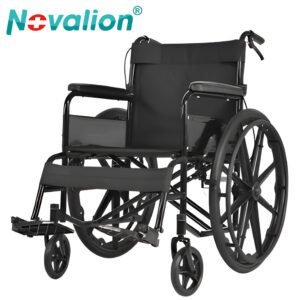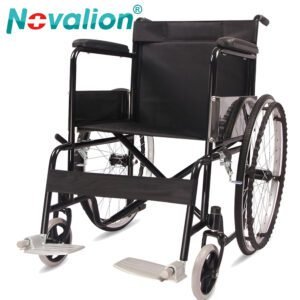Custom Manual Wheelchair: 5 Key Questions Answered—From Design to User Fit & Functionality
For users who rely on manual wheelchairs, one-size-fits-all models often fall short. A custom manual wheelchair is engineered to match your body, strength, and daily routine—turning the effort of self-propulsion into a seamless, even empowering, experience. But what makes a manual wheelchair “custom,” and how does it transform daily life? Here are 5 critical questions answered.
1. What Defines a Custom Manual Wheelchair?
A custom manual wheelchair is built from the ground up to align with a user’s unique physical needs and lifestyle—no generic sizing or one-size-fits-most compromises. Key traits include:
- User-Specific Dimensions: Frame width, seat depth, and hand rim placement are based on precise measurements (e.g., arm length, shoulder width) to optimize self-propulsion.
- Manual Focus: Unlike powered wheelchairs, it relies on the user’s upper-body strength—so customization prioritizes reducing effort (e.g., ergonomic hand rims for weak grips).
- Tailored Support: Seats, backrests, and armrests are contoured to the user’s posture, preventing pain or fatigue during long sits.
Key Difference from Standard Manual Wheelchairs: Standard models (16–18 inch seats, fixed hand rims) force users to adapt to the chair. Custom versions adapt to you.
2. What Is the Custom Design Process?
Creating a custom manual wheelchair is a collaborative journey, focused on manual functionality:
- Clinical Assessment: A physical or occupational therapist evaluates your strength (grip, arm power), posture (e.g., slouching, scoliosis), and daily activities (e.g., “needs to push up ramps” or “navigate office cubicles”).
- Measurement Mapping: Precise metrics are taken—from hip width (to size the seat) to arm length (to position hand rims at the optimal height for pushing).
- Prototype Testing: A adjustable frame is built to test fit. For example, if pushing causes shoulder pain, therapists may adjust hand rim angle or frame width during trials.
- Final Fabrication: The frame is welded to your dimensions, with custom components like contoured foam seats or ergonomic hand rims (e.g., padded, angled for easy gripping).
Timeline: 3–6 weeks (faster than custom powered wheelchairs, thanks to simpler mechanics).
3. Who Benefits Most from This Wheelchair?
It’s transformative for users whose needs outpace standard manual models:
- Users with Unique Body Shapes: Those with short arms, uneven limb lengths, or scoliosis—standard wheelchairs force awkward postures, leading to pain.
- Limited Upper-Body Strength: Arthritis, stroke, or spinal cord injury patients need ergonomic hand rims (e.g., larger, padded) to push with less effort.
- Long-Term Users: People in wheelchairs 6+ hours daily benefit from pressure-relief seats and lumbar support, reducing fatigue.
- Active Lifestyles: Commuters or students need narrow frames (for tight spaces) and lightweight materials (aluminum/carbon fiber) to maneuver busy streets or campuses.
4. What Features Can Be Customized?
Nearly every part is tailored to enhance manual use:
Frame & Propulsion:
- Width: Narrow (22 inches) for tight spaces or wide (26 inches) for stability—based on your environment.
- Hand Rims: Size (10–12 inches), shape (curved for grip), and padding (foam for sensitive hands) to ease pushing.
- Wheel Placement: Adjusted to reduce leverage effort—critical for users with weak arms.
Support Systems:
- Seat: Contoured foam or gel cushions (molded to your body) to prevent pressure sores.
- Backrest: Height (16–20 inches) and lumbar support (adjustable firmness) to maintain upright posture.
- Armrests: Padded, removable, or angled to avoid shoulder strain when pushing.
Materials: Aluminum (lightweight, 25–35 lbs) for easy maneuvering; steel (sturdier, 35–45 lbs) for heavy daily use.
5. How Does It Enhance Daily Functionality?
Customization turns struggle into independence:
- Easier Propulsion: Hand rims positioned at your arm’s natural pushing angle reduce shoulder strain—so you can push longer without fatigue.
- Better Maneuverability: A frame sized to your body (e.g., narrow for apartment hallways) lets you navigate tight spaces solo, no caregiver needed.
- Pain Prevention: Contoured seats distribute weight evenly, avoiding pressure points that cause soreness in standard chairs.
- Confidence: Knowing the chair fits youmakes tasks like grocery shopping or visiting friends feel less daunting.
Conclusion
A custom manual wheelchair isn’t just a mobility aid—it’s an extension of your body. By tailoring every detail to your strength, shape, and life, it turns manual propulsion from a chore into a tool for independence. For users who rely on their own strength to move, this customization is life-changing.
Thank you for reading this, dear, if you have any suggestions about our website or want to know about wheelchair, please contact us. We will respond quickly.



